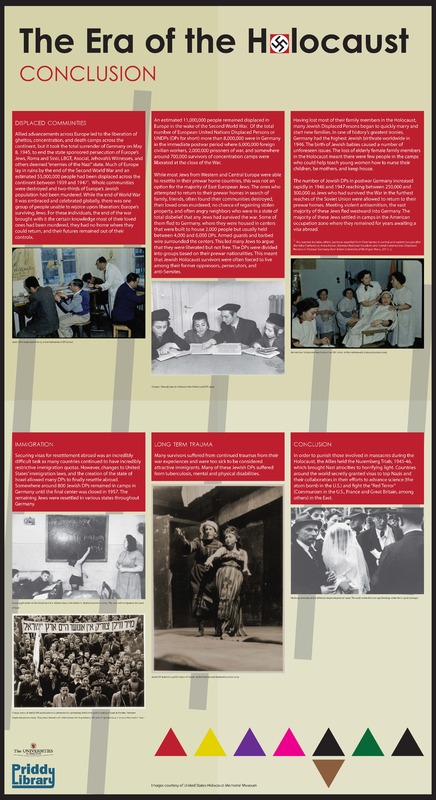Conclusion
DISPLACED COMMUNITIES
Allied advancements across Europe led to the liberation of
ghettos, concentration, and death camps across the
continent, but it took the total surrender of Germany on May
8, 1945, to end the state sponsored persecution of Europe’s
Jews, Roma and Sinti, LBGT, Asocial, Jehovah’s Witnesses, and
others deemed “enemies of the Nazi” state. Much of Europe
lay in ruins by the end of the Second World War and an
estimated 55,000,000 people had been displaced across the
continent between 1939 and 1947. Whole communities
were destroyed and two-thirds of Europe’s Jewish
population had been murdered. While the end of World War
II was embraced and celebrated globally, there was one
group of people unable to rejoice upon liberation: Europe’s
surviving Jews. For these individuals, the end of the war
brought with it the certain knowledge most of their loved
ones had been murdered, they had no home where they
could return, and their futures remained out of their
control.
An estimated 11,000,000 people remained displaced in
Europe in the wake of the Second World War. Of the total
number of European United Nations Displaced Persons or
UNDPs (DPs for short) more than 8,000,000 were in Germany
in the immediate postwar period where 6,000,000 foreign
civilian workers, 2,000,000 prisoners of war, and somewhere
around 700,000 survivors of concentration camps were
liberated at the close of the War.
While most Jews from Western and Central Europe were able
to resettle in their prewar home countries, this was not an
option for the majority of East European Jews. The ones who
attempted to return to their prewar homes in search of
family, friends, often found their communities destroyed,
their loved ones murdered, no chance of regaining stolen
property, and often angry neighbors who were in a state of
total disbelief that any Jews had survived the war. Some of
them fled to Germany, where they were housed in centers
that were built to house 2,000 people but usually held
between 4,000 and 6,000 DPs. Armed guards and barbed
wire surrounded the centers. This led many Jews to argue
that they were liberated but not free. The DPs were divided
into groups based on their prewar nationalities. This meant
that Jewish Holocaust survivors were often forced to live
among their former oppressors, persecutors, and
anti-Semites.
Having lost most of their family members in the Holocaust,
many Jewish Displaced Persons began to quickly marry and
start new families. In one of history’s greatest ironies,
Germany had the highest Jewish birthrate worldwide in
1946. The birth of Jewish babies caused a number of
unforeseen issues. The loss of elderly female family members
in the Holocaust meant there were few people in the camps
who could help teach young women how to nurse their
children, be mothers, and keep house.
The number of Jewish DPs in postwar Germany increased
rapidly in 1946 and 1947 reaching between 250,000 and
300,000 as Jews who had survived the War in the furthest
reaches of the Soviet Union were allowed to return to their
prewar homes. Meeting violent antisemitism, the vast
majority of these Jews fled westward into Germany. The
majority of these Jews settled in camps in the American
occupation zone where they remained for years awaiting a
visa abroad.
IMMIGRATION
Securing visas for resettlement abroad was an incredibly
difficult task as many countries continued to have incredibly
restrictive immigration quotas. However, changes to United
States’ immigration laws, and the creation of the state of
Israel allowed many DPs to finally resettle abroad.
Somewhere around 800 Jewish DPs remained in camps in
Germany until the final center was closed in 1957. The
remaining Jews were resettled in various states throughout
Germany.
LONG TERM TRAUMA
Many survivors suered from continued traumas from their
war experiences and were too sick to be considered
attractive immigrants. Many of these Jewish DPs suffered
from tuberculosis, mental and physical disabilities.
CONCLUSION
In order to punish those involved in massacres during the
Holocaust, the Allies held the Nuremberg Trials, 1945-46,
which brought Nazi atrocities to horrifying light. Countries
around the world secretly granted visas to top Nazis and
their collaborators in their efforts to advance science (the
atom bomb in the U.S.) and fight the “Red Terror”
(Communism in the U.S., France and Great Britain, among
others) in the East.
